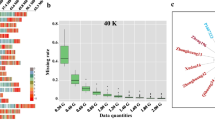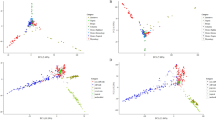Abstract
Single nucleotide polymorphisms (SNPs) are abundant and evenly distributed throughout the genomes of most plant species. They have become an ideal marker system for genetic research in many crops. Several high throughput platforms have been developed that allow rapid and simultaneous genotyping of up to a million SNP markers. In this study, a custom GoldenGate assay containing 1,536 SNPs was developed based on public SNP information for maize and used to genotype two recombinant inbred line (RIL) populations (Zong3 x 87-1, and B73 x By804) and a panel of 154 diverse inbred lines. Over 90% of the SNPs were successfully scored in the diversity panel and the two RIL populations, with a genotyping error rate of less than 2%. A total of 975 SNP markers detected polymorphism in at least one of the two mapping populations, with a polymorphic rate of 38.5% in Zong3 x 87-1 and 52.6% in B73 x By804. The polymorphic SNPs in B73 x By804 have been integrated with previously mapped simple sequence repeat markers to construct a high-density linkage map containing 662 markers with a total length of 1,673.7 cM and an average of 2.53 cM between two markers. The minor allelic frequency (MAF) was distributed evenly across 10 continued classes from 0.05 to 0.5, and about 16% of the SNP markers had a MAF below 10% in the diversity panel. Polymorphism rates for individual SNP markers in pair-wise comparisons of genotypes tested ranged from 0.3 to 63.8% with an average of 36.3%. Most SNPs used in this GoldenGate assay appear to be equally useful for diversity analysis, marker-trait association studies, and marker-aided breeding.




Similar content being viewed by others
Abbreviations
- BAC:
-
Bacteria artificial chromosomes
- DH:
-
Doubled haploid
- EST:
-
Expression sequence tag
- FPC:
-
Fingerprinted contigs
- LD:
-
Linkage disequilibrium
- LOD:
-
Logarithm-of-odds
- MARS:
-
Marker-assisted recurrent selection
- MAS:
-
Marker-assisted selection
- NAM:
-
Nested association mapping
- NSF:
-
National science foundation
- OPA:
-
Oligo pool assay
- PCR:
-
Polymerase chain reaction
- QTL:
-
Quantitative trait locus
- RFLP:
-
Restriction fragment length polymorphisms
- RIL:
-
Recombinant inbred lines
- SAM:
-
Sentrix array matrix
- SNP:
-
Single nucleotide polymorphism
- SSR:
-
Simple sequence repeat
- STS:
-
Sequence tagged site
References
Altschul SF, Gish W, Miller W, Myers EW, Lipman DJ (1990) Basic local alignment search tool. J Mol Biol 215:403–410
Bernardo R (2008) Molecular markers and selection for complex traits in plants: learning from the last 20 years. Crop Sci 48:1649–1664
Blanc G, Wolfe KH (2004) Widespread paleopolyploidy in model plant species inferred from age distributions of duplicate genes. Plant Cell 16:1667–1678
Buckler ES, Stevens NM (2005) Maize Origins, Domestication, and selection. In: Motley TJ, Zerega N, Cross H (eds) Darwin’s harvest. Columbia University Press, New York, pp 67–90
Chander S, Guo YQ, Yang XH et al (2008) Using molecular markers to identify two major loci controlling carotenoid contents in maize grain. Theor Appl Genet 116:223–233
Fan JB, Chee MS, Gunderson KL (2006a) Highly parallel genomic assays. Nat Rev Genet 7:632–644
Fan JB, Gunderson KL, Bibikova M et al (2006b) Illumina universal bead arrays. Methods Enzymol 410:57–73
Gao SB, Martinez C, Skinner DJ et al (2008) Development of a seed DNA-based genotyping system for marker-assisted selection in maize. Mol Breeding 22:477–494
Gupta PK, Rustgi S, Mir RR (2008) Array-based high-throughput DNA markers for crop improvement. Heredity 101:5–18
Hamblin MT, Warburton ML, Buckler ES (2007) Empirical comparison of simple sequence repeats and single nucleotide polymorphisms in assessment of maize diversity and relatedness. PLoS ONE 2:e1367
Helentjaris T, Slocum M, Wright S et al (1986) Construction of genetic linkage maps in maize and tomato using restriction fragment length polymorphisms. Theor Appl Genet 72:761–769
Helentjaris T, Weber D, Wright S (1988) Identification of the genomic locations of duplicate nucleotide sequences in maize by analysis of restriction fragment length polymorphisms. Genetics 118:353–363
Hyten DL, Song Q, Choi IY et al (2008) High-throughput genotyping with the GoldenGate assay in the complex genome of soybean. Theor Appl Genet 116:945–952
Lincoln S, Daly M, Lander E (1992) Constructing genetics maps with MAPMAKER/EXP 3.0. Whitehead Institute Technical Report, Whitehead Institute, Cambridge
Liu K, Goodman MM, Muse S et al (2003) Genetic structure and diversity among maize inbred lines as inferred from DNA microsatellites. Genetics 165:2117–2128
Lu H, Bernardo R (2001) Molecular diversity among current and historical maize inbreds. Theor Appl Genet 103:613–617
Ma XQ, Tang JH, Teng WT et al (2007) Epistatic interaction is an important genetic basis of grain yield and its components in maize. Mol Breeding 20:41–51
McMullen MM, Kresovich S, Villeda HS et al (2009) Genetic properties of the maize nested association mapping population. Science 325:737–740
Rostoks N, Ramsay L, MacKenzie K et al (2006) Recent history of artificial outcrossing facilitates whole-genome association mapping in elite inbred crop varieties. Proc Natl Acad Sci USA 103:18656–18661
Saghai Maroof MA, Soliman KM, Jorgensen RA et al (1984) Ribosomal DNA spacer length polymorphisms in barley: Mendelian inheritance, chromosomal location, and population dynamics. Proc Natl Acad Sci USA 81:8014–8018
Senior L, Lynn M, Heun M (1993) Mapping maize microsatellites and polymerase chain reaction confirmation of the targeted repeats using a CT primer. Genome 36:884–889
Song XF, Song TM, Dai JR et al (2004) QTL mapping of kernel oil concentration with high-oil maize by SSR markers. Maydica 49:41–48
Teng WT, Can JS, Chen YH et al (2004) Analysis of maize heterotic groups and patterns during past decade in China. Sci Agric Sin 37:1804–1811
Yu JM, Holland JB, McMullen MD et al (2008) Genetic design and statistical power of nested association mapping in maize. Genetics 178:539–551
Acknowledgments
We highly appreciate the molecular and functional diversity team of the NSF Maize Genome Project for making available all the SNPs information used in this study. We thank Dr. Ortiz Rodomiro (CIMMYT) for his critical review this manuscript. This research was supported by the National Hi-Tech Research and Development Program of China and the Bill & Melinda Gates Foundation through the Drought Tolerant Maize for Africa project (http://dtma.cimmyt.org/).
Author information
Authors and Affiliations
Corresponding authors
Electronic supplementary material
Below is the link to the electronic supplementary material.
Rights and permissions
About this article
Cite this article
Yan, J., Yang, X., Shah, T. et al. High-throughput SNP genotyping with the GoldenGate assay in maize. Mol Breeding 25, 441–451 (2010). https://doi.org/10.1007/s11032-009-9343-2
Received:
Accepted:
Published:
Issue Date:
DOI: https://doi.org/10.1007/s11032-009-9343-2




